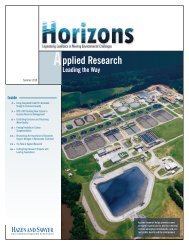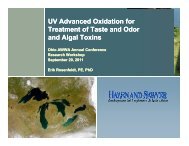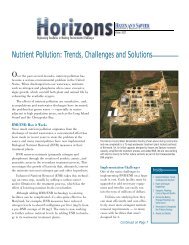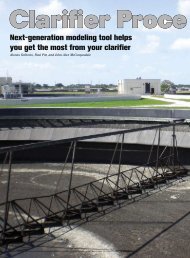full article - Hazen and Sawyer
full article - Hazen and Sawyer
full article - Hazen and Sawyer
You also want an ePaper? Increase the reach of your titles
YUMPU automatically turns print PDFs into web optimized ePapers that Google loves.
The new Peekskill Water<br />
Treatment Plant faced several<br />
design complexities, including<br />
connecting the new facility <strong>and</strong><br />
high-service pumps to the existing<br />
clearwell without interrupting<br />
service; installing a new intake;<br />
<strong>and</strong> managing a project site<br />
underlain with bedrock, requiring<br />
costly excavation. An awardwinning<br />
approach was used to<br />
optimize the conventional DAF<br />
process <strong>and</strong> include a pump<br />
station that allowed the plant<br />
to be constructed at grade,<br />
minimizing excavation.<br />
photograph: <strong>Hazen</strong> <strong>and</strong> <strong>Sawyer</strong><br />
for conventional DAF <strong>and</strong> 12 gpm/ft 2 <strong>and</strong><br />
16 gpm/ft 2 for high-rate DAF. The lower<br />
loading rates (6 gpm/ft 2 <strong>and</strong> 12 gpm/ft 2 )<br />
averaged lower floated-water turbidities;<br />
filtered water quality parameters varied.<br />
The pilot data confirmed that both<br />
DAF processes, followed by filtration,<br />
provided high-quality finished water (low<br />
filtered-water turbidity <strong>and</strong> high p<strong>article</strong><br />
removal) <strong>and</strong> maintained adequate filterrun<br />
lengths. Filtered-water turbidity was<br />
consistently less than 0.1 ntu. Log p<strong>article</strong><br />
removal ranged from 1.1 to 2.8 for optimized<br />
runs. Unit filter run volumes consistently<br />
exceeded the 7,500-gal/ft 2 pilot<br />
goal.<br />
Iron <strong>and</strong> manganese in the filtered<br />
water were frequently undetectable <strong>and</strong><br />
reliably less than the 0.02-mg/L pilot<br />
goal. Organics removal ranged from<br />
40 percent to 50 percent for specialized<br />
TOC testing, <strong>and</strong> ultraviolet analysis indicated<br />
removal greater than 75 percent.<br />
These high removal rates would help<br />
the city meet federal st<strong>and</strong>ards regarding<br />
DBP formation.<br />
The pilot data confirmed both processes<br />
provided high-quality, lowturbidity<br />
finished water <strong>and</strong> high p<strong>article</strong><br />
removal, with adequate filter run-lengths.<br />
Therefore, further evaluations were conducted<br />
to determine which technology<br />
was best suited for the site’s space, height,<br />
<strong>and</strong> depth requirements. Conceptual<br />
building <strong>and</strong> site layouts were prepared<br />
for both processes, <strong>and</strong> comparative cost<br />
estimates were developed.<br />
DESIGN AND CONSTRUCTION<br />
Computational fluid dynamics (CFD) was<br />
used to optimize facility design <strong>and</strong> minimize<br />
plant footprint <strong>and</strong> excavation depth<br />
<strong>and</strong> extent. Flocculation tanks of the same<br />
width were dedicated to the respective<br />
DAF–filtration tanks. This innovative layout<br />
enabled pinpoint floc to form <strong>and</strong> be<br />
removed in less time, allowing for more<br />
compact flocculator layout <strong>and</strong> decreased<br />
structural <strong>and</strong> excavation costs. CFD modeling<br />
confirmed that this arrangement<br />
wouldn’t result in uneven flow distribution<br />
to the DAF saturator zone. CFD modeling<br />
was also used to refine spacing of<br />
the transition baffles between the flocculation<br />
basins <strong>and</strong> DAF tanks, providing<br />
efficient layout.<br />
Although high-rate DAF resulted in<br />
a smaller flotation area, it required a<br />
deeper tank <strong>and</strong> larger flocculation area<br />
than conventional DAF. Evaluations demonstrated<br />
that the conventional DAF process<br />
was cost-effective <strong>and</strong> required less<br />
space than high-rate DAF. Therefore, conventional<br />
DAF was selected for design<br />
<strong>and</strong> construction.<br />
Because the high-rate DAF process<br />
operates at much higher loading rates<br />
than conventional DAF, it seems intuitive<br />
that the high-rate process would<br />
save money because of its smaller footprint.<br />
However, analysis demonstrated<br />
that, after optimizing the flocculation<br />
basin arrangement, there was little difference<br />
in overall footprints of the two processes,<br />
<strong>and</strong> the high-rate process didn’t<br />
meet the owner’s footprint or cost–benefit<br />
criteria.<br />
SYSTEM BENEFITS<br />
The new plant began serving customers<br />
in May 2010. The cost-efficient<br />
treatment process effectively removes<br />
organics, producing finished water that<br />
consistently meets DBP limits, which<br />
the old plant had seasonally exceeded.<br />
The quality of water from the new plant<br />
significantly improves public health for<br />
Peekskill residents.<br />
The American Council of Engineering<br />
Companies recognized the new facility<br />
with a 2011 Gold Award because it<br />
exhibits the successful evaluation of<br />
alternate treatment processes, pilot-scale<br />
studies of options within the selected process,<br />
optimization of the selected treatment,<br />
<strong>and</strong> life-cycle cost analysis. The<br />
approach established the most costeffective<br />
treatment alternative <strong>and</strong> optimized<br />
plant design, taking into account<br />
considerable site constraints <strong>and</strong> the need<br />
to provide continuous service throughout<br />
construction.<br />
www.awwa.org/opflow November 2012 Opflow 15








